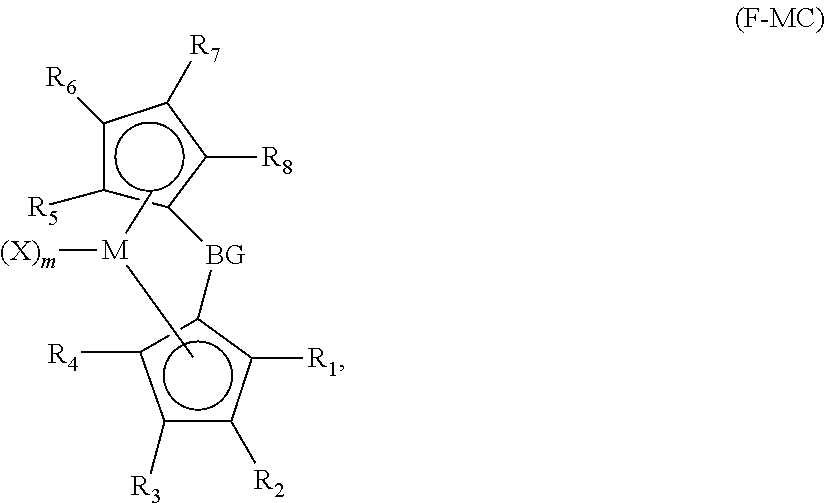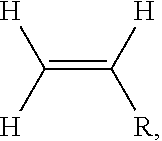Metallocene-Catalyzed Polyalpha-Olefins
a technology of polyalpha-olefins and catalysts, applied in the field of polyalpha-olefins (“ pao”) materials, to achieve the effects of high selectivity, low selectivity, and high selectivity
- Summary
- Abstract
- Description
- Claims
- Application Information
AI Technical Summary
Benefits of technology
Problems solved by technology
Method used
Image
Examples
examples
Part A
Syntheses of Metallocene Compounds
[0178]All syntheses were carried out in an N2 purged dry box using standard air sensitive procedures. Ligands (such as substituted or unsubstituted Cp, indene, 9H-fluorene) used in the synthesis are commercially available from reagent suppliers such as Sigma Aldrich (www.sigmaaldrich.com) and Boulder Scientific Company (www.bouldersci.com). Lithiated ligands can be made by reacting the ligands with n-BuLi as illustrated and exemplified in U.S. Patent Application Publication No. 2013 / 0023633 A1. Ligands bridged by the bridging groups can be synthesized by reacting the lithiated ligands and SiMe2Cl2, as illustrated and exemplified in U.S. Publication No. 2013 / 0023633 A1. In the synthesis processes, to the extent two stereo isomers exist in any of the metallocene compounds, a mixture of the two isomers are produced. Therefore, even if the molecular formula shown below appears to represent a single isomer, interpretation thereof should mean a mixt...
example a1
Synthesis of Metallocene Compound I-1: Me2Si(Me4Cp)(3-Prind)ZrMe2
[0179]
[0180]The solid dilithio salt (1.22 g, 2.6 mmol) of Me2Si(Me4Cp)(3-Prind)Li2 was slurried in Et2O (50 ml) and reacted with ZrCl4 (0.613 g, 2.6 mmol). After stirring for 4 hours, the reaction was complete as determined by crude 1H NMR. The reaction was filtered and the solids were washed by dichloromethane 3 times. All solvents were removed in vacuum, and the off-green solid (1.0 g) was collected. The product was re-slurried in toluene (20 ml) and reacted with MeMgI (1.75 ml, 3 M in Et2O). The reaction was stirred at 68° C. for 4 hours. Crude 1H NMR showed that reaction was complete. The reaction mixture was cooled to room temperature and 1,4-dioxane (0.6 ml) was added. The mixture was stirred for 20 min and the all solids were removed by filtration and washed by dichloromethane. After removal of all solvents, solid (0.82 g) was isolated as the final methylated product, Me2Si(Me4Cp)(3-Prind)ZrMe2, which was analyz...
example a2
Synthesis of Metallocene Compound I-2: Me2Si(Me4Cp)(3-PrInd)HfMe2
[0181]
[0182]3-propylindenyl lithium (1.50 g, 9.1 mmol) was dissolved in THF (30 ml) and reacted with CpMe4HMe2SiCl (1.96 g, 9.1 mmol). The reaction was stirred overnight at room temperature. Crude 1H NMR showed that the reaction was complete. All volatiles were removed and the crude product was re-slurried into pentane. The crude product was filtered through Celite. All volatiles were then removed in vacuum. Product was isolated as clear oil and was dissolved in Et2O (20 ml). 11M n-Bu-Li in hexanes (1.7 ml, 18.3 mmol) was then slowly added. The reaction was stirred for 3 hours at room temperature. Crude 1H NMR showed that the reaction was complete. Pentane (40 ml) was added to the reaction mixture and it was stirred for 30 min. The product was isolated by filtration as white solid (2.1 g), which was washed by pentane twice during filtration. The solid dilithiated product was slurried in Et2O (50 ml) and reacted with Hf...
PUM
| Property | Measurement | Unit |
|---|---|---|
| Fraction | aaaaa | aaaaa |
| Fraction | aaaaa | aaaaa |
| Fraction | aaaaa | aaaaa |
Abstract
Description
Claims
Application Information
 Login to View More
Login to View More - Generate Ideas
- Intellectual Property
- Life Sciences
- Materials
- Tech Scout
- Unparalleled Data Quality
- Higher Quality Content
- 60% Fewer Hallucinations
Browse by: Latest US Patents, China's latest patents, Technical Efficacy Thesaurus, Application Domain, Technology Topic, Popular Technical Reports.
© 2025 PatSnap. All rights reserved.Legal|Privacy policy|Modern Slavery Act Transparency Statement|Sitemap|About US| Contact US: help@patsnap.com



